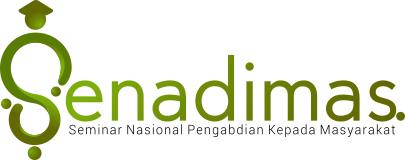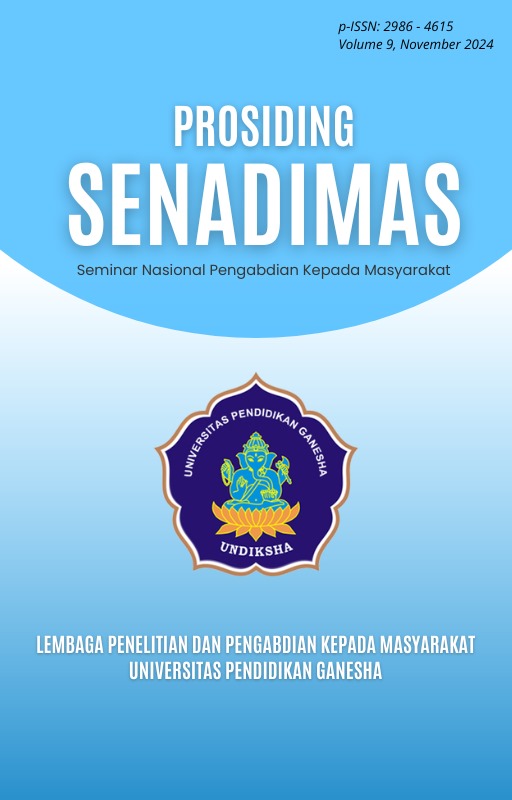PENINGKATAN KAPASITAS KELOMPOK PENGELOLA DAN PENATAAN KEGIATAN PENGELOLAAN KAWASAN PESISIR DI DESA PENUKTUKAN
Kata Kunci:
Pengelolaan Kawasan Pesisir, Laporan Keuangan, Peningkatan Kapasitas, Pemberdayaan Masyarakat, Pelatihan dan PendampinganAbstrak
Kawasan pesisir Desa Penuktukan memiliki potensi ekonomi yang belum dimanfaatkan secara optimal, terutama di sektor pariwisata dan pengelolaan sumber daya laut. Kondisi ini disebabkan oleh beberapa faktor, antara lain: (1) kurangnya pengetahuan dan keterampilan masyarakat dalam pengelolaan kawasan pesisir, (2) belum adanya sistem zonasi lokal yang terpadu, dan (3) infrastruktur pendukung yang belum memadai. Program pengabdian ini bertujuan untuk meningkatkan kapasitas kelompok pengelola dan menata kegiatan pengelolaan kawasan pesisir di Desa Penuktukan melalui pelatihan dan pendampingan. Fokus pelatihan meliputi: (1) peningkatan pengetahuan tentang pengelolaan kawasan pesisir, (2) teknik monitoring ekosistem terumbu karang, dan (3) penyusunan dokumen pengelolaan kawasan pesisir. Hasil yang diharapkan dari program ini adalah peningkatan kapasitas masyarakat dan terwujudnya pengelolaan kawasan pesisir yang berkelanjutan di Desa Penuktukan.
Referensi
Allen, G. R., Steene, R., & Allen, M. (2018). A Guide to Angelfishes & Butterflyfishes. Tropical Reef Research.
Aswani, S., & Hamilton, R. J. (2018). Integrating indigenous ecological knowledge and customary sea tenure with marine and social science for conservation of bumphead parrotfish (Bolbometopon muricatum) in the Solomon Islands. Environmental Conservation, 45(2), 148-159.
Cabanban, A. S. (2011). Coral reef fisheries and their management in the Philippines: a review. Journal of Environmental Science and Management, 14(1), 1-10.
Chou, L. M., & Chen, W. J. (2005). A review of the trade in reef fishes from coral reefs vulnerable to environmental degradation in Southeast Asia: Vietnam, Cambodia, Indonesia, and the Philippines. Marine Conservation Society, 2, 23-56.
CITES (Convention on International Trade in Endangered Species of Wild Fauna and Flora). (2021). About CITES. https://cites.org/eng/disc/about.php
Delbeek, J. C., & Sprung, J. (1994). The Reef Aquarium: A Comprehensive Guide to the Identification and Care of Tropical Marine Invertebrates (Vol. 1). Ricordea Publishing.
Diggles, B. K., Bartlett, C. Y., Brown, E. E., McLeod, I. M., & Ogburn, M. B. (2016). A review of international, regional, and national legal frameworks for the management of marine ornamental fisheries. Reviews in Fisheries Science & Aquaculture, 24(4), 321-333.
Fenner, R. M. (2014). The Conscientious Marine Aquarist: A Commonsense Handbook for Successful Saltwater Hobbyists (2nd ed.). TFH Publications.
Fenner, D., & Banks, S. (2004). The trade in coral species harvested from the wild for the aquarium hobby: An update. Aquarium Sciences and Conservation, 6(1), 1-20.
Gjerde, K. M., Cullis-Suzuki, S., & Ardron, J. (2019). Securing a just and sustainable future for marine biodiversity beyond national jurisdiction: The need for a new legally binding instrument. Marine Policy, 105, 14-21.
Helfman, G. S., Collette, B. B., & Facey, D. E. (2019). The Diversity of Fishes: Biology, Evolution, and Ecology (2nd ed.). Wiley-Blackwell.
Hoeksema, B. W. (2015). The reef-building coral genera of the Dutch Caribbean. Netherlands Centre for Biodiversity Naturalis.
Lamb, J. B., True, J. D., Piromvaragorn, S., & Willis, B. L. (2018). Scuba diving damage and intensity of tourist activities increases coral disease prevalence. Biological Conservation, 222, 102-108.
Lieske, E., & Myers, R. (1999). Coral Reef Fishes: Indo-Pacific and Caribbean. Princeton University Press.
Pyle, R. L. (2001). Fishes: An Introduction to Ichthyology (4th ed.). Pearson Education.
Randall, J. E., Allen, G. R., & Steene, R. (1997). Fishes of the Great Barrier Reef and Coral Sea. University of Hawaii Press.
Sadovy de Mitcheson, Y. J. (2002). The global trade in marine ornamental species: a review. Marine Fisheries Review, 64(2), 1-9.
Schumacher, B. D. (2017). Coral reefs and international trade: new trends, products, and implications. Environmental Science & Policy, 76, 183-191.
Scott, M. (2005). Marine Aquarium Fish: A Pocket Expert Guide to All Species. T.F.H. Publications.
Sprung, J. (2001). Reef Fishes: A Guide to Their Identification, Behavior and Captive Care. T.F.H. Publications.
Suwa, R., Tsukamoto, K., & Inoue, T. (2020). Coral Trade in Southeast Asia: Status, Regulation, and Challenges. Environmental Management, 66(2), 225-240.
Tullock, J. H. (2011). Natural Reef Aquariums: Simplified Approaches to Creating Living Saltwater Microcosms. Microcosm/TFH.
United Nations General Assembly. (2015). Transforming our world: the 2030 Agenda for Sustainable Development. https://www.un.org/sustainabledevelopment/sustainable-development-goals/
Wabnitz, C., Taylor, M., Green, E., & Razak, T. (2003). From Ocean to Aquarium: The Global Trade in Marine Ornamental Species. UNEP-WCMC, Cambridge, UK.
Wijgerde, T., Dooijewaard, N., & Bak, R. P. M. (2019). Coral Reefs and Their Animals. In Marine Animal Forests (pp. 1-34). Springer, Cham.
Unduhan
Diterbitkan
Terbitan
Bagian
Lisensi
Hak Cipta (c) 2024 Seminar Nasional Pengabdian kepada Masyarakat

Artikel ini berlisensiCreative Commons Attribution-ShareAlike 4.0 International License.



